Related Research Articles
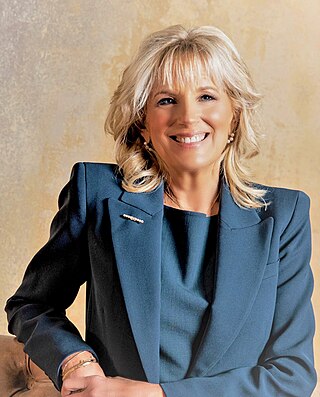
The first lady of the United States (FLOTUS) is the title held by the hostess of the White House, usually the wife of the president of the United States, concurrent with the president's term in office. Although the first lady's role has never been codified or officially defined, she figures prominently in the political and social life of the United States. Since the early 20th century, the first lady has been assisted by official staff, now known as the Office of the First Lady and headquartered in the East Wing of the White House.

Theodore Roosevelt Jr., often referred to as Teddy or by his initials, T. R., was an American politician, statesman, soldier, conservationist, naturalist, historian, and writer who served as the 26th president of the United States from 1901 to 1909. He previously served as the 25th vice president under President William McKinley from March to September 1901 and as the 33rd governor of New York from 1899 to 1900. Assuming the presidency after McKinley's assassination, Roosevelt emerged as a leader of the Republican Party and became a driving force for anti-trust and Progressive policies.
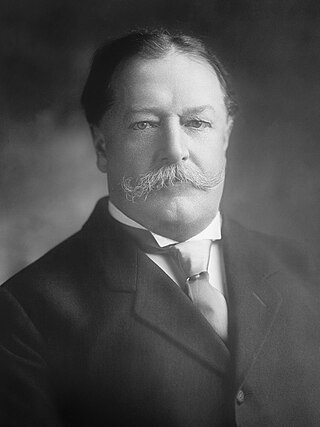
William Howard Taft was the 27th president of the United States (1909–1913) and the tenth chief justice of the United States (1921–1930), the only person to have held both offices. Taft was elected president in 1908, the chosen successor of Theodore Roosevelt, but was defeated for reelection in 1912 by Woodrow Wilson after Roosevelt split the Republican vote by running as a third-party candidate. In 1921, President Warren G. Harding appointed Taft to be chief justice, a position he held until a month before his death.

The 1908 United States presidential election was the 31st quadrennial presidential election, held on Tuesday, November 3, 1908. Secretary of War and Republican Party nominee William Howard Taft defeated three-time Democratic nominee William Jennings Bryan.
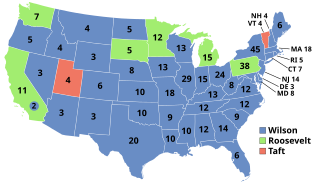
The 1912 United States presidential election was the 32nd quadrennial presidential election, held on Tuesday, November 5, 1912. Democratic Governor Woodrow Wilson unseated incumbent Republican President William Howard Taft and defeated former President Theodore Roosevelt, who ran under the banner of the new Progressive or "Bull Moose" Party. This is the most recent, and the only post-Civil War presidential election in which the second-place candidate was neither a Democrat nor a Republican. This is the most recent election to date in which four candidates received over five percent of the vote.
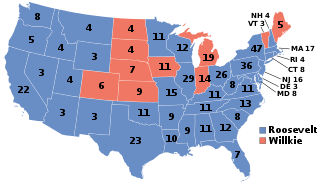
The 1940 United States presidential election was the 39th quadrennial presidential election. It was held on Tuesday, November 5, 1940. Incumbent Democratic President Franklin D. Roosevelt defeated Republican businessman Wendell Willkie to be reelected for an unprecedented third term in office.

The Payne–Aldrich Tariff Act of 1909, named for Representative Sereno E. Payne (R–NY) and Senator Nelson W. Aldrich (R–RI), began in the United States House of Representatives as a bill raising certain tariffs on goods entering the United States. The high rates angered Republican reformers, and led to a deep split in the Republican Party.
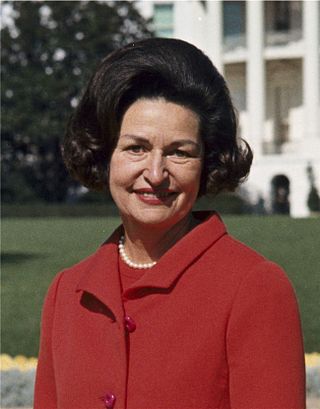
Claudia Alta "Lady Bird" Johnson was the first lady of the United States from 1963 to 1969 as the wife of President Lyndon B. Johnson. She previously served as the second lady from 1961 to 1963 when her husband was vice president.

Helen Louise Taft, known as Nellie, was the first lady of the United States from 1909 to 1913 as the wife of President William Howard Taft. Born to a politically well-connected Ohio family, she took an early interest in political life, deciding at the age of 17 that she wished to become first lady. Herron married Taft in 1886, and she guided him throughout his political career, encouraging him to take actions that would bring him closer to the presidency. Accompanying her husband to the Philippines in 1900, she became a prominent socialite in Manila, contributing to US-Philippines relations. After her husband was appointed Secretary of War, she played a significant role in convincing him to run for president in the 1908 presidential election and making the necessary connections to ensure his success.

The presidency of Theodore Roosevelt started on September 14, 1901, when Theodore Roosevelt became the 26th president of the United States upon the assassination of President William McKinley, and ended on March 4, 1909. Roosevelt had been the vice president for only 194 days when he succeeded to the presidency. A Republican, he ran for and won by a landslide a four-year term in 1904. He was succeeded by his protégé and chosen successor, William Howard Taft.

The 1912 Republican National Convention was held at the Chicago Coliseum, Chicago, Illinois, from June 18 to June 22, 1912. The party nominated President William H. Taft and Vice President James S. Sherman for re-election for the 1912 United States presidential election.

The Progressive Party was a third party in the United States formed in 1912 by former president Theodore Roosevelt after he lost the presidential nomination of the Republican Party to his former protégé rival, incumbent president William Howard Taft. The new party was known for taking advanced positions on progressive reforms and attracting leading national reformers. The party was also ideologically deeply connected with America's indigenous radical-liberal tradition.
These are the references for further information regarding the history of the Republican Party in the U.S. since 1854.

The Republican Party, also referred to as the GOP, is one of the two major political parties in the United States. It is the second-oldest extant political party in the United States after its main political rival, the Democratic Party.
Dollar diplomacy of the United States, particularly during the presidency of William Howard Taft (1909–1913) was a form of American foreign policy to minimize the use or threat of military force and instead further its aims in Latin America and East Asia through the use of its economic power by guaranteeing loans made to foreign countries. In his message to Congress on 3 December 1912, Taft summarized the policy of Dollar diplomacy:

The presidency of William Howard Taft began on March 4, 1909, when William Howard Taft was inaugurated as 27th president of the United States, and ended on March 4, 1913. Taft, was a Republican from Ohio. The protégé and chosen successor of President Theodore Roosevelt, he took office after easily defeating Democrat William Jennings Bryan in the 1908 presidential election. His presidency ended with his defeat in the 1912 election by Democrat Woodrow Wilson.
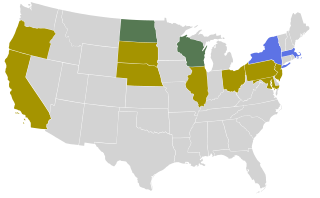
From March 19 to June 4, 1912, delegates to the 1912 Republican National Convention were selected through a series of primaries and caucuses to determine the party's nominee for President in the 1912 election. Incumbent President William Howard Taft was chosen over former President Theodore Roosevelt. Taft's victory at the national convention precipitated a fissure in the Republican Party, with Roosevelt standing for the presidency as the candidate of an independent Progressive Party, and the election of Democrat Woodrow Wilson over the divided Republicans.
The following are some of the books and papers which have been written concerning William Howard Taft, the 27th president of the United States:
This bibliography of Theodore Roosevelt is a list of published works about Theodore Roosevelt, the 26th president of the United States. The titles are selected from tens of thousands of publications about him.
The following is a list of works about the spouses of presidents of the United States. While this list is mainly about presidential spouses, administrations with a bachelor or widowed president have a section on the individual that filled the role of First Lady. The list includes books and journal articles written in English after c. 1900 as well as primary sources written by the individual themselves.
References
- ↑ Lewis L. Gould, ed. Watching Television Come of Age: The New York Times Reviews by Jack Gould (University of Texas Press, 2002),
- ↑ Jacques Cattell Press, Directory of American Scholars: History (7th ed. 1978) p. 341.
- ↑ Barry McNamara, "Pioneer Historian Retired Monmouth professor Lewis Gould receives inaugural award from first ladies association," Monmouth College July 7, 2021 online
- ↑ Jacques Cattell Press, Directory of American Scholars: History (7th ed. 1978) p. 341.
- ↑ Lewis L. Gould, "First Lady as Catalyst: Lady Bird Johnson and Highway Beautification in the 1960s" Environmental Review 10.2 (1986): 77–92.
- ↑ "Lewis Gould Honored as Inaugural Recipient of FLARE Award" (July 26, 2021, Briscoe Center for American History) online
- ↑ Stephen Ponder, "Four Hats in the Ring" Presidential Studies Quarterly (2011) 41#1 pp. 204-206.
- ↑ Edward O. Frantz, "Review." Journal of American History (Dec 2010) 97#3 p. 829